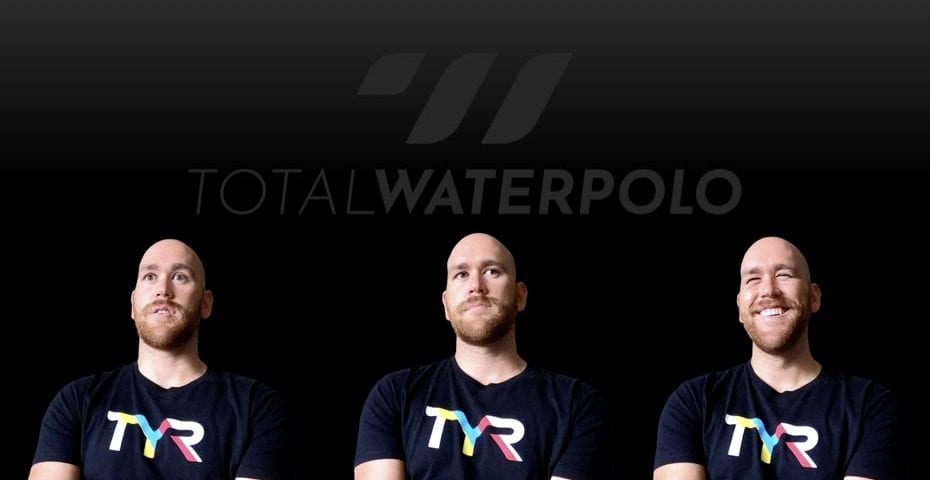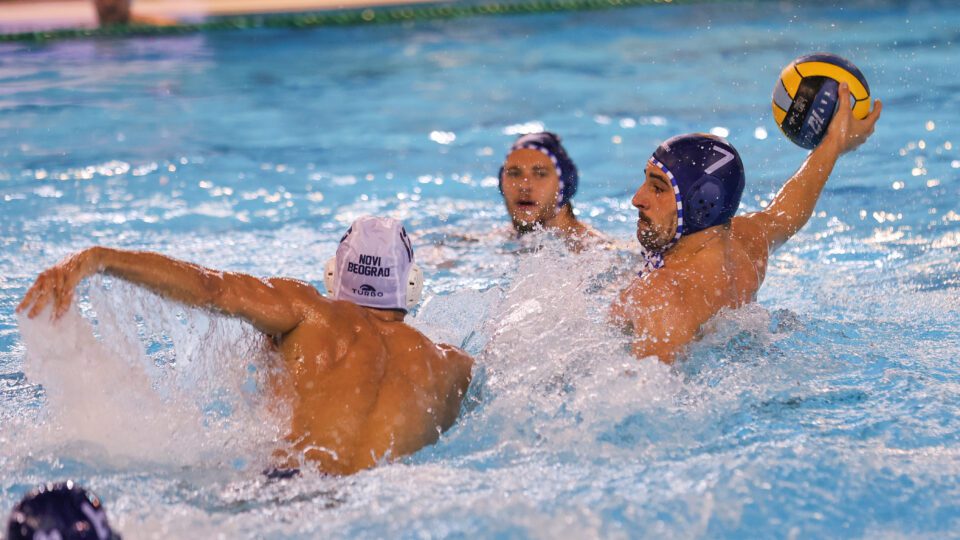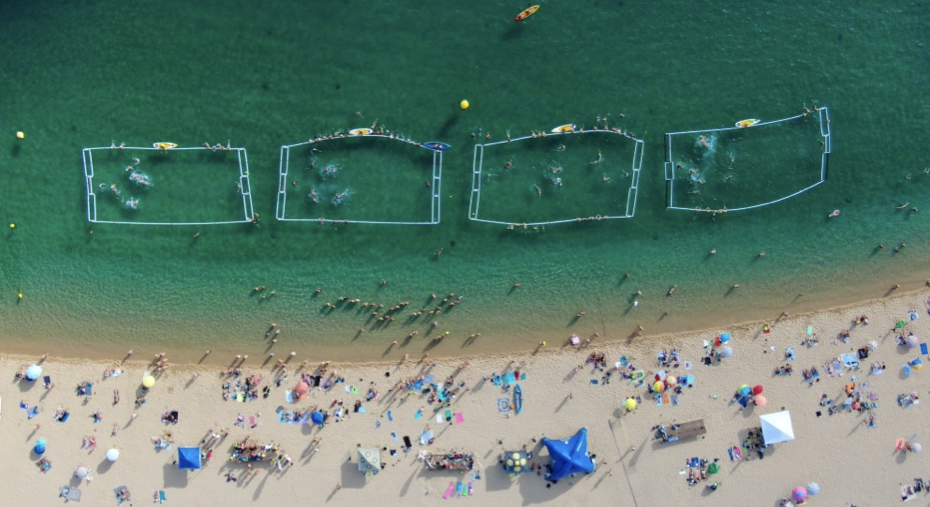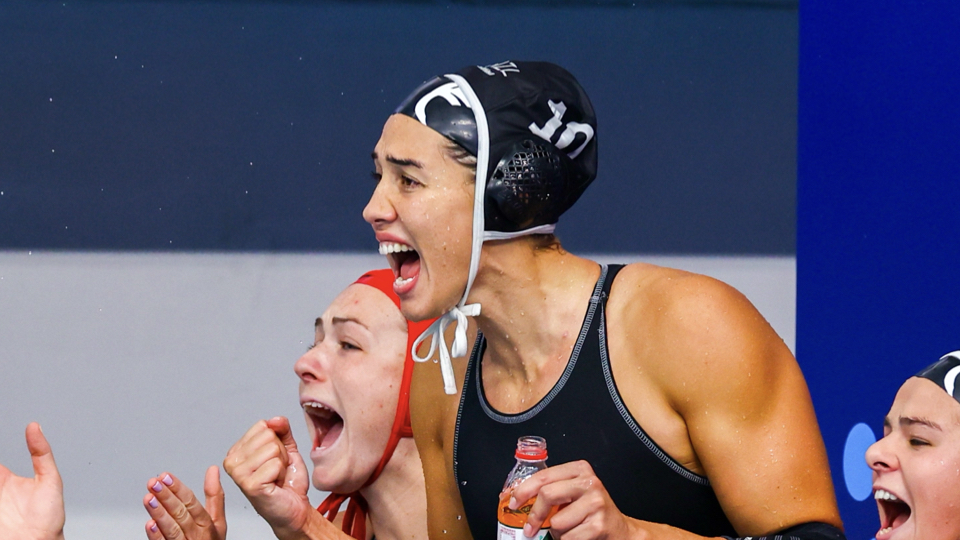Alex Bowen, one of the best shooters of the Team USA, has been playing in Europe since the season 2015/2016. His European adventure started in Steaua Bucharest, but he didn’t stay for a long in this club. Then, he moved to Miskolc (Hungary), where he spent three seasons. Last year, he joined Mladost Zagreb.
A very successful season is behind him. Playing for Mladost, he won the Regional League and the Croatian Cup. He left a strong mark in Croatia, but this summer he decided to continue gaining experience in another quality league. Bowen moved to Greece. He will play for Apollon, the club that composed a strong team and will hunt for trophies in the next season.
In an interview with Total Waterpolo, Bowen spoke about his career, differences between American and European water polo, and more.
Bowen started playing water polo at a very young age. This sport is his family’s tradition since Alex’s father is a water polo coach.
“When I was six, seven, eight years old, my father used to pick me up after school and bring me to the pool. I splashed around in, in the shallow end, while he got training. I taught myself how to swim and throw a ball by watching others. I started playing with the under-12-year group when I was seven or eight years old. I think I had my first tournament and went to the junior Olympics (a big American water polo tournament for kids – Ed.) when I was nine.”
Alex said that he had played at the Junior Olympics with his pre-high school team. But, a few years later, he was forced to change the club.
“After a couple of years, some of the guys moved, and the pre-high team fell apart. So I joined up the bigger club -San Diego Shores and played with them throughout high school.”
What is the competition system in high schools in the USA? Many Europeans do not know much about it.
” High school teams play games from August to November. And then, for the rest of the year, you play with your club. So in the winter, there are not that many tournaments. In the spring and summer, everything is very condensed. There are a lot of games and traveling every weekend. Some clubs are also just the high school team. So they practice their high school teams all year round. On the other side, there are clubs, like the club I played for San Diego Shores, that combine a lot of the high school teams in the area to make a better team.”
What are the highest levels of high school and club competitions in the USA?
“All the important competitions for clubs are under the USA Water Polo Federation. Groups of clubs run some other leagues. As for high schools, we have CIF, which is the big regional championship. San Diego has one, Los Angeles and Orange County also have their regional competitions, etc. Recently, four or five years ago, the state championships have been launched. I never played at the state championships. But, in brief, the state championship is two weeks after the CIF. Some of the teams take it seriously.”
Dream about Stanford came true
Bowen attended Stanford University, where he scored over 200 goals and earned many awards. He was voted the MVP of the 2014 final tournament of the Mountain Pacific Sports Federation (the most quality college conference in the USA). Three times, he was chosen for the 1st Team All-American (a hypothetical the best team the season composed of amateur players)
“I knew where I was going after one month in my senior year of high school, which was amazing. Everybody else in my school hated me for it. There’s a recruiting process with the NCAA (National Collegiate Athletic Association). Many rules have to be followed in the contacts between players and the colleges.
Only a couple of colleges came for me, because I made my choice pretty clearly and early. I wanted to go to Stanford. When I got accepted, there was no real reason for anybody else to talk to me. Still, I spoke to USC and Princeton for a little bit. Stanford was my ultimate choice, and it was my dream to go there.”
How does a student’s day, who is also a water polo player, look like at Stanford University?
“It depends on the season. Stanford is a quarter system. You have four quarters of the year. Fall is a water polo season. So, you usually have a couple of classes less. Players are focused on water polo a little bit more. When I was there, we had the morning training from 7 AM to 8.45, and classes would start at 9 AM. So it depends on how your schedule is set up, and then we had another practice from 3 PM to 6 PM. The players used to be in the pool for about five hours a day and had a lot of training in the gym. There are rules on how long you can practice. And it’s about 20 hours of training per week. Sometimes you have a couple of weeks with 30 hours of training, but the NCAA tries to keep some things restricted.”
In the winter and the spring, the NCAA teams don’t have games. The classes become a priority.
“That’s when you really load up on the classes. The school year starts with an easy quarter, continues with a hard quarter, and then spring is whatever you can do.”
Big four of NCAA
How competitive is the NCAA Championships?
“NCAA is very competitive. In the last 10, 20 years, it’s mostly been won by California, USC, UCLA, or Stanford. USC was pretty dominant for a while. But, UCLA, California, and Stanford stepped up. These four teams won all the championships since 1997. The league has gotten even better in recent years because there’ve been a lot of teams outside of those big four that have made pretty good runs.”
The last season, only two of the teams of the “Big-four” reached the semifinals.
“Stanford and USC faced off in one of the semifinals. I think that the other semifinal was Pepperdine and Pacific, and they had very good seasons, as well. In the final, Stanford crushed Pacific. I was super proud of my boys. The championship has been getting more competitive year by year, which is fantastic. And I think it’s in big part is because water polo has grown so much in the United States and continues to, so I’m happy to see that, too.”
In recent years, women’s water polo has been developed a lot in the USA.
“The USA Water Polo Federation is doing a good job by expanding the female water polo. More and more clubs are getting involved. I think that, in the last ten years, the USA Water Polo membership has gone up every year.”
What is the American players’ and coaches’ perception of the European water polo? Did you try to find some content online, watch role models there, or are you like a more close community with your own?
“I think it is a little bit more closed. In my time, the information wasn’t available as it is now. A lot of it was just talking word of mouth. I knew everybody on the national team, and they were my role models. I went to the camps when I was 12 years old. I went to watch Ryan Bailey, Tony Azevedo. It was great, but that was the only kind of interaction that we could get. Today, it’s different. And I think you guys had done a good job on one of those issues.”
The semifinal games of the Croatian league were streamed on Total Waterpolo’s Facebook page. Water polo fans in the USA could watch Bowen playing for Mladost.
“After that, so many people were texting me, since they became interested in the Croatian playoffs.”
Many of the American water polo players didn’t know a lot about European water polo. They didn’t know who the biggest stars in Europe were. But things are getting better.
“It’s great that a lot of matches are available online now. I talked with players and friends in the USA. Many of them like to watch European games. They want to see who makes a difference in the pool. There is plenty out there, which is nice. Ten years ago, you didn’t have anything.”
Who were your water polo and sport role models?
“In water polo, it’s Tony Azevedo. He was a huge inspiration. I played with him in the last Olympics, and the dream came true. It was awesome. For sports models in general, there are two big ones from San Diego Padres – Trevor Hoffman and Tony Gwynn. They are two members of the Hall of fame baseball players. Tony Gwynn had a great way with words and knew to help teammates. There is a reason why he should be idolized, and there’s a reason why San Diego loves him.”
No many options for USA water polo players after graduating
What are the options for the American water polo players after they finish college and graduate?
“There aren’t that many options realistically. USA Water Polo has done a good job by creating the US national league. But it’s not quite enough. Still, they’re building on it, and they’re doing a better job every year. It’s a process of creating a league in the USA. Realistically, what happens is guys from the national team – after graduating, a lot of them will play for the Olympic Club in San Francisco, or the New York Athletic Club. I am in the New York Athletic Club, and I have all the benefits of a member. For example, I have got a great place to stay in New York. I haven’t been able to go there often, but I always had a great time when I go.
But a lot of the players from Stanford and Cal and basically anybody who moves up into the San Francisco Bay Area for work will be part of the Olympic club. I know there are rivals, but I have to say that they have incredible facilities. I have plenty of friends that went that route.”
Although he plays in Europe, Bowen is still a member of the New Your Athletic Club.
“I play for New York whenever I’m in the United States, and I am free. I play with them in the national league, US Open, etc.”
In your opinion, what is the main reason that more American players don’t come to Europe? Is there no interest from the European club? Is the money a problem?
“There are a couple of reasons. It is hard to find contacts. My first contact was through the New York Athletic Club. It was a weird path, but one call can help. It’s hard for a regular college player, who is not on a national team, to be seen by the Europeans. In the last few years, more and more guys from the US have come out to play abroad. But, four years ago, I was the only guy out there.”
There was a period when a lot of American players were in Europe, like Ryan Bailey, Jessie Smith, Tony Azevedo, etc.
“All those guys retired at the same time, which was a blessing and a curse at the same time. After their retirement, I got to the national team, and I still keep my position. But, with all those guys retiring, I was the only one left who played in Europe. Everybody else was younger than me and still in college. But now, everybody’s starting to graduate, and we have more and more national team players in Europe. In the next season, 12 players of the Team USA will play for the European clubs. Most of them are coming to Greece and I will be one of them.”
Differences between American and European water polo
What do you think, what is the difference between the approach and the everyday practice and the water polo mentality in the United States and Europe? Was it the shock when you came to Hungary?
“I think things were a little bit more relaxed here. In the USA, training sessions are longer, with more swimming. In Europe, they break it up a little bit more. We have three-hour training in the States – one hour we’ll be swimming and then passing shooting and then we’ll scrimmage. It’s a lot more relaxed in Europe, which is good. It’s just different styles. Players in the USA really work hard all the time. I’m not saying we don’t work hard here, but it’s slightly more relaxed and different.”
How tactical approaches in Europe and the USA differ?
“Coaches in the USA have a lot more schemes. They try to create some kind of drive combination to open people up, and it turns into a system. In Europe, it is – you know how to play the game, go, and play. That’s a little bit different.”
In Europe, some basic things you need to learn when you’re a kid. For example, one hour of the training for seven and eight-year-old boys in Mladost consists of passing the ball, which must remain dry.
“I can agree with that. There are some basics that I’ve learned here, and I should have known this when I was younger. I think there’re different basics that the US tries to teach, and there are some things that are getting better. One big thing is the program USA Water Polo Pipeline, which serves as the feeder system for the USA youth, cadet, and development national teams. A lot of those basics are back into the program.
The guys are getting a lot more opportunities, a lot more training trips to Europe. My first trip to Europe was in 2010 to play a tournament. That was the first time I went with a junior team anywhere. When I was finally able to go out and train and play against some of the players from other countries it was so much better. I got a new motivation – a hundred percent.”
Romanian short episode, and great Hungarian experience
Bowen has been playing in Europe in continuity since the season 2015/2016. In his first club, Steaua, he didn’t stay for a long. Alex played the Romanian Cup and a few matches after the tournament. But, shortly after, he had to come back to the USA.
“There were some things that happened with the national team, and the schedule wasn’t as now it’s. I had to go and play with the national team at the World League Qualification Tournament. It was important for us to qualify for the World League, which wasn’t a big problem. Still, we were hosting the tournament, and they wanted the whole team there. I could fly back to Romania the night after the last game and maybe come for the fifth match of the Romanian playoffs’ final. But it would involve 20 hours of air travel, and I would come five hours before the game. So, there was no reason for me to go back. We talked about it, and there’s no bad blood between me in the club. “
He moved to Hungary to Miskolc in 2016.
“I had a good experience there. It was really interesting because I signed with Miskolc right before the Olympics in Rio de Janeiro. USA and Montenegro trained together before the Olympics. On that occasion, I met Sasa Misic, who also joined Miskolc.”
Bowen said that he was very satisfied with the results during three seasons in Miskolc.
“We reached the LEN Euro Cup semifinals. We ended with losing to Marseille, that won the trophy later. Miskolc got fifth place in the Hungarian league twice, which qualified us for the LEN cup. I’ve had very successful seasons there. I was very happy with how everything went there.”
Regional and Hungarian League are very comparable
The next stop of Bowen’s career was Mladost.
“I was contacted by Mladost two years ago. I was still Miskolc’s player. They showed interest after I had a really good game in the World League. The coach came up to me and asked me: “Wish you come to play in Mladost”. And it happened a year later.
Can you compare the Hungarian and the Regional League, which are two of the world’s toughest water polo competitions?
“They are comparable. The Hungarian league is a “monster” of a league. When I went back to the States, I explained that we got fifth place. And everyone said: “What are you talking about?” They just don’t understand how strong the Hungarian League is. Eger, Ferencvaros, Szolnok, OSC are” monsters” of teams.”
Bowen agrees that Regional and the Hungarian League are very similar.
“It the past season’s Regional League, we had four teams that played in the Champions League. Three Hungarian clubs also took part in the Champions League. The top four teams from Hungary are pretty comparable to the top four of the Regional League.”
Water polo is one of the most popular sports in Hungary. Most of the matches are played in front of the packed stands, fans get more involved in the games than in Croatia.
“Yes. The atmosphere was great. It was great to be part of it. Miskolc is a relatively new club, so they were still establishing a fan base. But some of the games, like matches against Ferencvaros, OSC, and the games in the LEN Euro Cup, we played in a packed house. Everybody was yelling the entire game. It was awesome.
In the States, there are only a couple of games that you play in an atmosphere like this. The games between the big rivals, Stanford, California, UCLA, USC, will pack the house. These games have been usually scheduled on the same day as the (American) football game between the same colleges. I know for us, there’s a “Big Splash”, the encounter between California and Stanford in football and every sport has its own little twist on it. We’d always play that game in the morning or like around noon because the football game would have prime time. So we’d have people come to watch water polo before football. Especially for the big games, everybody was very excited. The fans are an important part of the sport. It’s amazing when you get out in front of a huge crowd, especially for water polo.”
Greece is a new stop
From next season, Bowen will play in the Greek League. He signed with Apollon.
“I’m excited to go to Greece. It’s going to be awesome. I am looking forward to playing on the same team with the athletes whom I respect a lot, such as Stefan Mitrovic and Alexandros Gounas, who are great players and were my opponents. I believe Apollon can play very well in Greece and Europe.”
The European water polo map changed a lot this summer. Many good players changed the clubs. Some of the leagues became stronger and balanced, like the leagues of Greece, France, etc.
“One of the reasons for that is because there are a lot of foreigners that had to leave Hungary because of the rule change. A lot of players had to find new contracts and clubs. They were forced to go out of their pretty comfortable areas. Many leagues will be much more balanced than in the previous season. Brescia might dethrone Pro Recco in Italy. Champions League will be also very interesting. Titleholder Ferencvaros lost a lot because Aaron Younger moved to Recco. He did a lot for Ferencvaros, but, still, they have a great team with a lot of “killers”.
Favorite victory
Can you remember a game that has been your favorite one?
“One of the most special games in my entire career was the 2019 Pan American Games final when we qualified for the Olympics. We beat Canada. We had trouble with them earlier in the tournament. We played just a terrible game against them, but we won in the group stage. In the final, everybody on our team was pumped up, fired up, and we just rolled over them. It was special because we get the gold medal and earned an Olympic berth.”
And was there any moment when you wanted to quit?
“Not really. I’ve loved the sport for a long time. My passion for water polo started with getting close to my dad. Also, I had so many great friends growing with me. I became able to play at the highest level, to play with the national team. There’s a lot of pride in playing for my country. I feel I have a very good connection and friendship with every single person I’ve played with. And it’s that tight-knit community that water polo provides, I think it is one of the most special things about our sport.”
Denes Varga and Andrija Prlainovic
Who has been your toughest opponent so far?
“Denes Varga. I had to play against him four or five, sometimes six times a year in Hungary. It was hard, especially in my first year in Hungary, to play against Denes and Andrija Prlainovic. That was my nightmare. I have to be on a hundred percent when they are my opponents. But I love playing against them. Every time I go up against Denes and Andrija, I always have a great time. I feel there’s some mutual respect.”
Benefit from postponement of Olympics
What are your expectations about the Tokyo Games? The USA has a young team. Some of the players of the other teams are now at their peak. But, since the Games were postponed for a year, maybe they fall and won’t be able to do their best.
“I think the new dates of the Games are better for us because we’re so young. Many players will get another year of experience. We have some major players that are young and who need a little bit more experience. We’ve got some very talented, younger players. Maybe the team changes a little bit, but I think the main guys on our team will get even better. I mean, the best way to look at this being positive. It’s great for us. A lot of the other teams are older than us, and I think age plays a factor. Because of the big break in the competitions, I think a lot of players will be healthier or recover from injuries. And then, maybe they will be a little bit fresher for the next year.”






